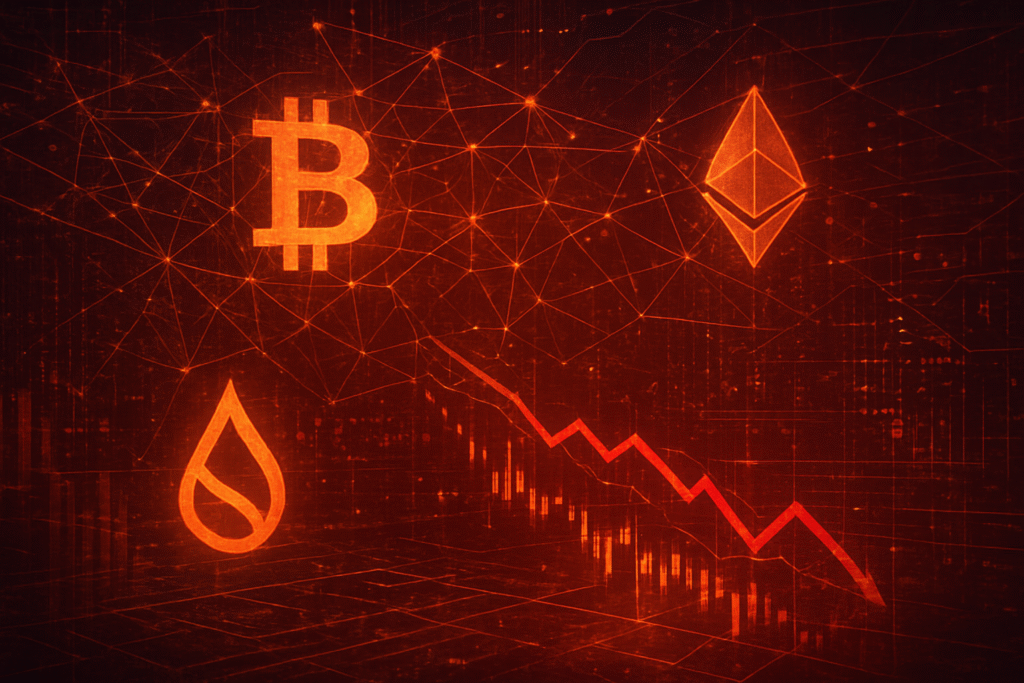
The cryptocurrency market has been gripped by a significant downturn in late 2025, witnessing a substantial decrease across most major digital assets. Bitcoin (BTC) and Ethereum (ETH) have led the retreat, but the spotlight has firmly been on Sui (SUI), a prominent Layer-1 blockchain, which has experienced a particularly sharp tumble that has reverberated throughout the ecosystem. This widespread contraction, most pronounced in October and November 2025, has seen the total crypto market capitalization plummet by over $1 trillion, erasing a substantial portion of the gains accrued earlier in the year.
The immediate market reaction has been one of severe contraction and fear. Bitcoin, after reaching its 2025 peak near $125,000 in early October, plunged below $82,000 by late November, marking its worst monthly performance since 2022. Ethereum mirrored this trend, losing over 40% of its value in the same period. For Sui, a significant price drop was noted in August 2025, followed by another sharp decline in November, including a 39% decrease over 30 days. This widespread capitulation has triggered massive liquidations, with over $19 billion in leveraged crypto positions forcibly wiped out in a single day in October, sending market sentiment into "extreme fear."
This period of intense volatility and value destruction holds profound significance for the crypto ecosystem. It underscores the deep interconnectedness of digital assets, demonstrating that even innovative Layer-1 blockchains like Sui are not immune to broader market sentiment and macroeconomic headwinds. The downturn also serves as a critical test of resilience for newer protocols, highlighting the pervasive influence of factors such as concerns over a potential AI/tech stock bubble, Federal Reserve interest rate expectations, and general risk aversion on the highly speculative cryptocurrency market. While severe, this market correction is largely seen as a "major risky correction" rather than a fundamental crisis, suggesting that the underlying infrastructure remains more robust compared to past systemic collapses.
Market Impact and Price Action
The late 2025 crypto market downturn delivered a sharp blow across the board, with Sui (SUI) exhibiting particularly acute price movements. Following a period of strong performance earlier in the year, Sui's token experienced significant retracements. In August, it plunged for three consecutive days, falling 21% below its annual high. The most recent decline in November saw SUI drop by 9.5% in a 24-hour window and a staggering 39% over a 30-day period, trading down 2.52% on November 26th. This velocity of decline was amplified across the broader market, with Bitcoin (BTC) shedding nearly $800 billion since its October peak and Ethereum (ETH) losing over 40% of its value between October and November.
Trading volumes for Sui, while experiencing initial spikes during the intense selling pressure, showed signs of waning demand. Reports indicated a 10% drop in 24-hour trading volume for SUI, accompanied by a decrease in futures open interest, signaling reduced speculative activity and a general drying up of liquidity as prices stabilized at lower levels. This pattern is typical of market corrections, where high selling volume often gives way to lower overall volume, indicating a potential "capitulation" phase where sellers are exhausted, but buyers remain cautious. The total crypto market capitalization, which peaked near $4.3 trillion on October 6th, fell to approximately $3.2 trillion by November 20th, a stark illustration of widespread liquidity withdrawal.
From a technical analysis perspective, Sui's price action displayed classic bearish patterns. In August, a clear head-and-shoulders chart pattern emerged, often a precursor to significant downward movement. In November, Sui struggled persistently against a descending trendline, failing to break above it. Key moving averages, once support, likely transformed into resistance levels, with a sustained break below the 200-day Moving Average (DMA) serving as a strong bearish signal. Indicators like the Relative Strength Index (RSI) and MACD consistently pointed to downward momentum, with RSI often dipping into oversold territory, a common characteristic of strong downtrends. Fibonacci retracement levels from Sui's preceding uptrend would likely show the price testing critical support zones, such as the 0.382, 0.5, or 0.618 levels, as it retraced a significant portion of its earlier gains.
Comparing this event to similar past market corrections, such as the 2018 bear market or the May 2021 and 2022 crashes, reveals familiar patterns. Newer and smaller-cap altcoins like Sui often experience more exaggerated percentage declines than Bitcoin or Ethereum due to their higher risk profiles and lower liquidity. Investors typically exhibit a "flight to safety," shifting funds from altcoins back into Bitcoin or stablecoins. The massive liquidation events observed in October 2025, with over $19 billion in leveraged positions wiped out, are a recurring feature of rapid price drops, exacerbating the downtrend through cascading margin calls. While painful, such periods often cleanse the market of excessive leverage and can set the stage for more sustainable growth, albeit after a period of consolidation and rebuilding confidence.
Community and Ecosystem Response
The dramatic market correction of late 2025, particularly the Sui (SUI) tumble, has elicited a complex and often polarized response from the crypto community and its broader ecosystem. Social media platforms like Crypto Twitter and Reddit were, as expected, inundated with discussions ranging from outright despair over liquidated portfolios to critical analyses of market vulnerabilities. The Crypto Fear & Greed Index plummeted, reflecting pervasive fear among investors that persisted into early November.
Community sentiment regarding Sui remained mixed in late November 2025. While some traders voiced concerns about Sui retesting its historical low of $0.46, others pointed to the underlying strength and growth of the network. The total number of accounts on Sui surged over 900% year-to-date in 2025, reaching 230 million from 26 million. This "sustained user adoption" during a "brutal correction phase" created a paradoxical situation for traders, where fundamental growth appeared to be decoupled from market valuation. Despite the price collapse, some analyses noted positive sentiment based on recent news and social media, even as the "Sui Fear and Greed Index" showed "Fear" shortly before late November. Discussions also highlighted a "deliberate, carefully planned oracle manipulation attack" that fueled distrust and calls for enhanced security within DeFi protocols, adding another layer of complexity to community concerns.
Crypto influencers and thought leaders largely echoed concerns about market stability, emphasizing the dangers of excessive leverage and the market's susceptibility to external shocks. Some viewed the crash as a "necessary 'reset'," while others expressed frustration over the perceived fragility of the ecosystem. Regarding Sui specifically, analyst Crypto Patel described the October price drop as a "classic capitulation flush," suggesting that the $1.7 to $1 range could represent an "institutional accumulation zone" where "forced liquidations complete. Weak hands out. Positioning reset." Prominent analyst Ali Martinez observed that SUI had returned to a rising support level that historically underpinned its major rallies, noting this "diagonal base" coincided with the bottoms of SUI's previous explosive cycles. Similarly, crypto trader and analyst Michael van de Poppe hinted at a potential reversal for SUI, noting its position just above a major long-term support. Beyond Sui, thought leaders like Robert Doyle speculated that increasing AI-driven cyberattacks would force institutions towards decentralized blockchain networks, potentially delaying the next market peak until 2026 due to macroeconomic pressures.
The market downturn had significant "collateral damage" on Sui's decentralized finance (DeFi) landscape. The Total Value Locked (TVL) on Sui plummeted by 64%, from $2.63 billion to $947.25 million, reflecting a loss of confidence from institutional investors and yield farmers. Stablecoin capitalization also saw a substantial decrease, and DEX trading volume on the Sui Chain dropped by over 50% since early October 2025. However, against this backdrop, Bluefin, a decentralized exchange built on Sui, recorded record volumes in October 2025, demonstrating isolated pockets of strength. The ecosystem also continued to expand with native stablecoins like USDsui and various DeFi protocols, contributing to a "robust financial layer." In the NFT sector, Sui showed "bullish" signs earlier in the year, with activity continuing into Q3 2025 despite the broader market woes. Developer momentum on Sui remained strong, with over 1,400 monthly active developers by mid-2025, a 219% increase from early 2024. The network's adoption strategy includes zkLogin for Web2 authentication in dApps and sponsored transactions to manage gas fees. In a significant sign of growing institutional validation, the Grayscale Sui Trust (GSUI) began trading on OTC markets in late November 2025, offering regulated exposure to US investors and placing Sui in the Bitwise 10 Crypto Index ETF alongside major cryptocurrencies. This suggests that despite the market turmoil, the underlying development and institutional interest in Sui's technology persist.
What's Next for Crypto
The late 2025 downturn, underscored by Sui's dramatic tumble, has significantly reshaped the immediate outlook for the crypto market, yet long-term projections remain cautiously optimistic. In the short term, the market is expected to remain cautious, grappling with the prevailing "extreme fear" sentiment and waning retail investor enthusiasm. Bitcoin (BTC) is struggling to hold critical support levels between $84,000 and $86,000, with a return to $100,000 by year-end largely contingent on potential interest rate cuts by the Federal Reserve. For Sui (SUI), short-term predictions for November 2025 ranged from $1.82 to $3.85, with some forecasts even suggesting a further dip to $1.15 by late December. However, analysts are closely watching SUI's long-term support trendline, which has historically preceded substantial rallies. Altcoins, generally, are anticipated to continue experiencing steeper declines than Bitcoin due to their lower liquidity.
Looking further ahead into 2026 and beyond, the long-term outlook for the crypto market remains largely optimistic. The market is increasingly viewed as maturing, transitioning from "speculative excess to tangible utility." Despite the current headwinds, earlier 2025 forecasts projected a robust Compound Annual Growth Rate (CAGR) of 31.3% through 2025, with Bitcoin potentially reaching $151,200 by year-end and Ethereum around $3,700. For Sui, if its key support trendline holds through December 2025, some analysts project a potential 500% rebound in 2026, which could push its price back towards its previous all-time high of $5.37 and possibly extend to $8.50. This downturn is largely seen as a "shake-out" period, where projects with weak fundamentals may collapse, allowing stronger, more resilient projects to emerge.
Several potential catalysts and developments are poised to influence the crypto market's trajectory. Macroeconomic policy shifts, particularly signals of Federal Reserve interest rate cuts, are considered a primary driver for recovery. Regulatory clarity, with the US having passed key legislation in 2025, including the GENIUS Act for stablecoins and the CLARITY Act to classify digital assets, and Europe's MiCA regulation fully operational, is expected to unlock substantial institutional capital. Continued institutional adoption, including positive inflows into various crypto ETFs and the rise of tokenized Real World Assets (RWAs), will also fuel growth. Technological advancements in AI integrated with blockchain, the growing importance of dApps, and Decentralized Physical Infrastructure Networks (DePINs) are anticipated to drive utility and adoption. Finally, on-chain indicators, such as extreme "fear" readings on the Crypto Fear & Greed Index and oversold Relative Strength Index (RSI) levels, have historically preceded market rebounds.
For projects, strategic considerations include a renewed focus on strong fundamentals, clear roadmaps, and robust ecosystems over speculative hype. Embracing utility and sustainability, navigating the evolving regulatory landscape, and investing in technological innovation like AI and Layer 2 scalability will be crucial. Transparency and education are paramount for building trust. For investors, risk management, diversification across large-cap cryptocurrencies, stablecoins, and selective DeFi assets are key. Dollar-Cost Averaging (DCA) and maintaining a long-term perspective are essential to navigate volatility. Identifying long-term winners with strong technology and real-world use cases, monitoring macro and regulatory signals, and exploring alternative yields (with caution) are also vital. Possible scenarios range from a gradual recovery (most likely), to a renewed bull run (moderately likely, beginning 2026 if catalysts align), to a deeper pullback (less likely), or stagnation (least likely but possible). The most probable path involves stabilization followed by a gradual recovery, with momentum building into 2026.
Bottom Line
The late 2025 crypto downturn, epitomized by the significant tumble of Sui (SUI), serves as a stark reminder of the inherent volatility within the digital asset landscape, yet simultaneously underscores the market's evolving maturity. Key takeaways for investors and enthusiasts include the undeniable impact of macroeconomic factors, such as the Federal Reserve's stance and broader market jitters, on crypto prices. Liquidity and excessive leverage continue to amplify price swings, leading to cascading liquidations. While strong project fundamentals are crucial, the recent events demonstrate that even robust ecosystems like Sui are not immune to market-wide downturns. Lastly, the persistent, albeit evolving, regulatory uncertainty remains a significant factor influencing market sentiment and participation.
In the long term, this event holds several significant implications. It acts as a necessary "shake-out" period, weeding out weaker projects and allowing more resilient, fundamentally strong initiatives to emerge. Crucially, institutional integration continues to accelerate, with financial institutions increasingly viewing crypto as a serious asset class and using corrections as accumulation opportunities. The downturn is also a catalyst for further regulatory evolution, with global bodies pushing for clearer frameworks to enhance consumer protection and market stability. This period of consolidation is refining investor behavior, encouraging a shift from speculative "hype tokens" towards more disciplined strategies focused on risk management, dollar-cost averaging, and fundamental analysis.
For crypto adoption, the late 2025 crypto downturn, while unsettling, represents a critical phase of refinement rather than a setback. The future of crypto adoption will be driven by accelerated institutional participation, a sustained focus on utility and robust technology, and improvements in user experience and accessibility. Projects that prioritize real-world applications and simplify interaction will be key. Regulatory clarity, despite its current fragmentation, is paramount for building trust and encouraging broader mainstream engagement. The market appears to be moving towards a more regulated, institutionalized, and utility-driven future, which bodes well for its long-term growth, even if punctuated by periods of significant volatility.
To navigate the evolving landscape, investors and enthusiasts should closely monitor several important dates, events, and metrics. Key dates include the Federal Open Market Committee (FOMC) meetings, such as December 9, 2025, for Federal Reserve interest rate decisions. Ongoing developments in global regulatory frameworks, particularly the full implementation of MiCA regulation in the EU by mid-2026 and pending crypto bills in the U.S., are crucial. Sui-specific events, such as future token unlock schedules, will also be important. Metrics to watch include Bitcoin dominance, adjusted stablecoin transaction volume, Total Value Locked (TVL) in DeFi protocols (especially on Sui), monthly mobile wallet users, and on-chain activity like active addresses and exchange flows. Additionally, open interest and funding rates in futures markets, along with broader sentiment analysis via the Fear & Greed Index, will offer valuable insights into market psychology and potential shifts.
This article is for informational purposes only and does not constitute financial or investment advice. Cryptocurrency investments carry significant risk.






